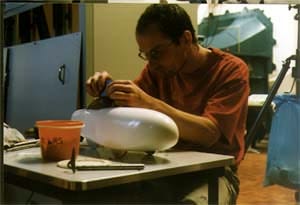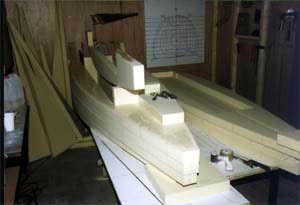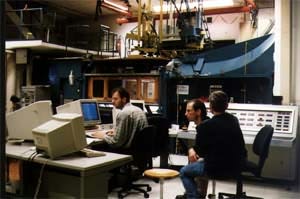- Home »
- Cycles »
- Quest »
- Development
Development
With the development of the Quest we searched for a bike with the best specification for speed and daily use. Speed is an important aspect of comfort. Even if you are not interested in riding fast. Riding a fast bike means that you can ride at "normal" speeds with little effort witch means you can cover a longer distance in a relaxed way.

The speed you can reach with a bike with a certain power depends mainly on the air resistance. The air resistance depends on the frontal area and the shape of your bike.
We reduced the frontal area of the bike by putting the seat in a low position and put the front wheels on a certain angle. Tests made clear that this angle would not affect the rolling resistance of the tyres. Together with the aerodynamic shapes, this results invery low air resistance. The boxes for the front wheels are covered on the outside to reduce drag. This reduces the ability to turn sharply, but there is just enough left for the Dutch cycle paths and roundabouts. It is possible to make the bike with open wheel boxes, this makes the bike easier to turn, but will give you a little more air drag.
The chain of the Quest stays inside the bike and outside the wheel covers. The chain is protected from water, dirt and salt from the road. This is a guarantee for minimal wear and low maintenance. The drive train is still easyly accessible and compatible with most standard race components.
The cover of the Quest is made of heat formed foam. The airflow generated by the rim around your head gives you protection from wind and rain. The soft foam is easy foldable, so you can take the cover with you in the back of your bike on warm days.
The coating of the Quest is made of polyester that is already put on in the mould. The moulds are made with ultimate care, which guarantees you a very smooth surface of the bike.
Aerodynamic design
 Base of the shape of the Quest is the "Darius windmill." This is a mill which is not turned toward the wind, but stays always in the same position. Useful for a bike that rides since you cannot choose the position of the road towards the wind. The profile we choose is one that is not too much influenced by little changes in length/width dimensions.
Base of the shape of the Quest is the "Darius windmill." This is a mill which is not turned toward the wind, but stays always in the same position. Useful for a bike that rides since you cannot choose the position of the road towards the wind. The profile we choose is one that is not too much influenced by little changes in length/width dimensions.
The model is formed by the calculation of the right dimensions for each horizontal layer where your body and the wheels would fit in.
 Because the development of an aerodynamic trike is a big investment in time and money we wanted to have more certainty about the created shape. The new shape had to have at least have 30% less air drag as the model we had (Flevobike C-Alleweder). Dr Leo Veldhuis of the University of Delft offered us the possibility to test 1:5 scale models of the old and the new bike.
Because the development of an aerodynamic trike is a big investment in time and money we wanted to have more certainty about the created shape. The new shape had to have at least have 30% less air drag as the model we had (Flevobike C-Alleweder). Dr Leo Veldhuis of the University of Delft offered us the possibility to test 1:5 scale models of the old and the new bike.
Current development
As always, everything can be improved. Because outside a flat country like Holland you'll need to climb hills very soon, foreign customers would like the quest to be equipped with a wider range gearing system. With the existing 3*20" configuration with a custom adapted derailleur, only sprockets with 12-28 at maximum could be used. However, for mountain bikes 11-34 sprockets are available, which need to be shifted with a long-arm derailleur. Important development rules of our bikes includes maintainance free chain drive which is covered from dirt and dust from the street, and the rear wheel still being single-side mounted for easy remounting of tyres while traveling. Another rule includes using standard universal shimano compatible sprockets and chain wheels and standard tools to perform maintainance to the bike. To combine these needs and rules, it wasn't easy to design a construction that would sufice.
When developing the first model of the quest, the possibility for a 26" rear wheel was taken into account. However, the bike was still equipped with a 20" rear wheel. To establish the needed transmission ratio, an extra axle in-between the chain line was used and placed under the seat. The sprocket was mounted on the extra axle with a custom adapted derailleur. This kind of configuration has advantages like using light 20" wheels and using three wheels with the same size, simpilfying backup tire maintainance. However, a larger wheel has its advantages too: the rolling resistance is lower, and better rolling behavior on bad road surface.


